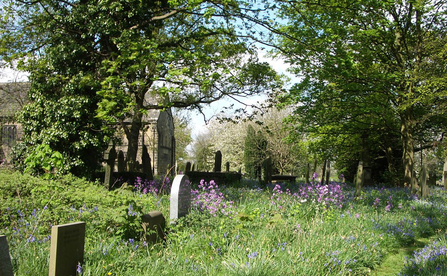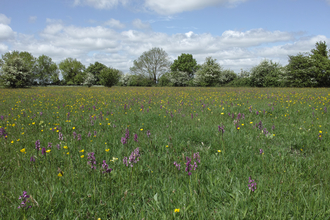
Many of our churchyards have escaped the dramatic loss of semi-natural habitat seen elsewhere. They can be very important for wildlife, providing a refuge for wide range of Suffolk’s flora and fauna. With sensitive management this wildlife can be encouraged without detracting from the spiritual and contemplative role of the churchyard.
Grassland
It is estimated that 90% of our herb-rich meadows have vanished in the last half century, The grassland found in churchyards is unlikely to have been fertilised or reseeded and is therefore often rich in wildflowers. Flower-rich grassland requires management. If left to its own devices, it will be overtaken by coarse grasses, more vigorous plants and scrub.
To maintain the floral diversity the grassland needs to be cut and the clippings removed. If left on, they smother delicate plants, and increase fertility which encourages rank growth at the expense of wildflowers.
If clippings are left to dry for a few days after cutting, this enables the flowers to shed any ripe seed and insects to make their escape. Cut vegetation can either be removed off site or used to create a small habitat pile in an out of the way corner where it will benefit creatures such as hedgehogs and slow-worms.
Cutting should be timed to allow the grasses and other species to flower and set seed. In most situations July is the best time for cutting, but this will vary depending on the local conditions and the range of species present. A further cut and rake off in September/October is often beneficial as the grass will be shorter in the spring giving the wildflowers a head start.
The selection of areas to be managed for wildflowers will depend not only on where the most wildflowers are, but also on the layout and use of the churchyard. In order to maintain a ‘cared for’ appearance, it is important to keep grass short adjacent to the main paths and to allow access to regularly attended graves. Cutting paths through the longer grass areas, and carefully defining their edges by regularly mown grass, shows that the ‘wildlife areas’ are part of a plan and allows visitors to appreciate them easily.
If there is space, leaving some areas uncut throughout the year is beneficial. Seed heads are a food source for birds and many invertebrates overwinter in long grass. The precise boundaries of these areas can be varied with cutting every 3 years to prevent the development of coarse grass and scrub.
Over the years, a mowing regime will have selected out certain plant species so if considering a change in management make incremental changes in small areas.
Other habitats
The variety of stone in boundary walls, gravestones and the church itself provides habitat for a range of mosses, ferns, lichens and drought tolerant plants. Lichens can take over 100 years to grow only a few centimetres and often protect gravestones from weathering, they should not be removed from gravestones unless necessary.
Ivy should be left on walls and trees to provide nesting sites and a late nectar source for insects whenever possible. If trimming or removal is necessary, this can done in autumn and winter to avoid the bird nesting season.
The trees and hedges of churchyards are valuable for wildlife providing food, shelter and nesting sites. Any necessary trimming or cutting back should be done in the winter months to minimise disturbance to wildlife. Some of the pruning’s can be used to create dead wood habitat piles. Use native species when planting new trees and avoid planting where they will shade out wildflower areas. Churchyard trees can provide home to bats all year round .Bats are fully protected by law. Seek advice from Suffolk Bat Group or Bat Conservation Trust and refer to resources from the Bats in Churches project.
Key principles
• Find out where you best areas for wildflowers are first, this is likely to be in the open sunny places,
• Be cautious when making big changes to historical management but be willing to review.
• If considering enhancing wildflower interest, look for green hay before seeding.
• Pathways to and around the church and those to tended graves should be kept mown,
• Boundaries that are clearly defined between closely cut grass and the longer wildflower areas demonstrate that the churchyard is well-managed rather than neglected.
• All grass cuttings should be raked up and removed from wildflower areas.
• Lichens, mosses and wall plants should not be removed from gravestones or walls.
• Consider the impact on existing meadow flora before tree planting.
• The presence of protected and priority species may affect your choices and management decisions.
• Avoid the use of chemicals.
• Displaying information which explains how and why the churchyard is managed is beneficial and encourages interest.
• Record species and submit your findings to Suffolk Biodiversity Information Services here https://www.suffolkbis.org.uk/
The benefits of managing churchyards
The sensitive management of a churchyard will not only help Suffolk’s wildlife, but can bring many benefits by:
• encouraging interest in the church and its surroundings by parishioners and visitors
• encouraging local involvement in the management of the churchyard
• providing a unique educational opportunity for people of all ages to learn about our natural and cultural heritage.
• Flower rich meadows enhance soil microbial diversity, carbon sequestration and storage so make a vital contribution to ameliorating climate change.
• Exemplar for sustainability—see Eco church.
A well managed churchyard is a beautiful place, which is not only a vital refuge for wildlife, but is also a focal point of the parish. The churchyard can be both a place for quiet reflection, and a place of interest where a variety of wildflowers and associated wildlife can be enjoyed. The churchyard will be a valued asset at the heart of the community.
If you would like to arrange an advisory visit to your Community Green Space, churchyard or Parish Council land contact Cathy Smith or call us on 01473 890089.
Be part of Team Wilder and take action for Suffolk’s Wildlife Team Wilder | Suffolk Wildlife Trust



